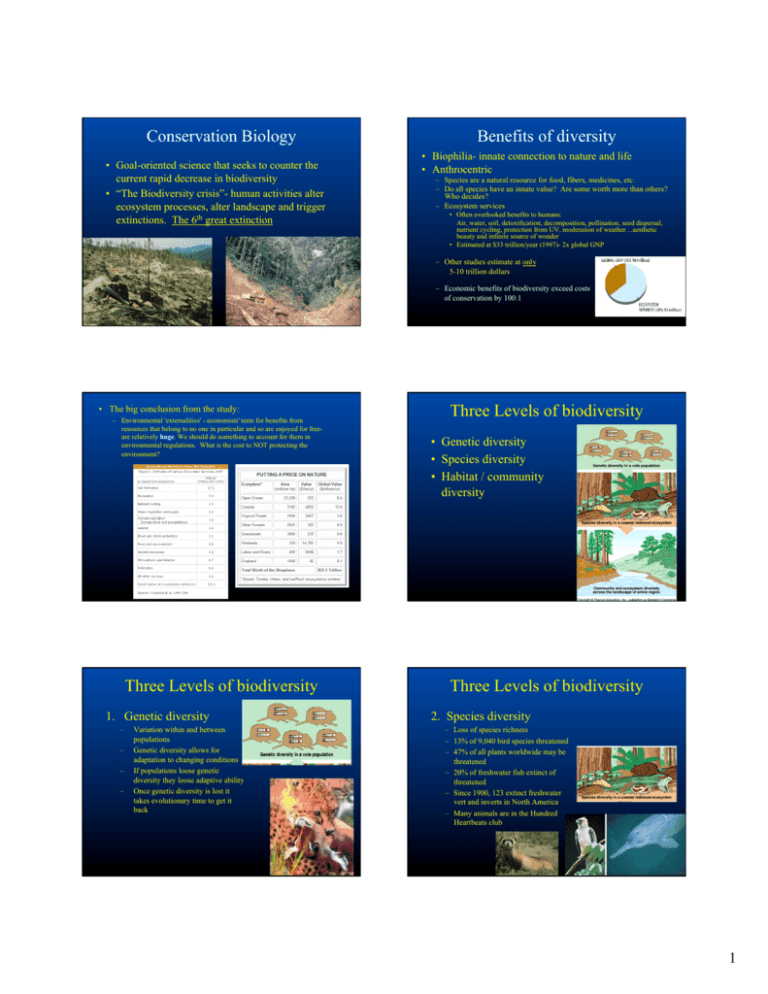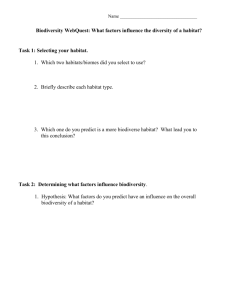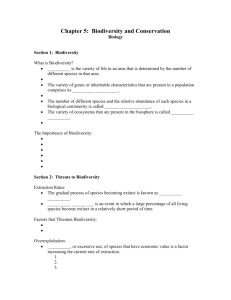Conservation Biology Benefits of diversity
advertisement

Conservation Biology • Goal-oriented science that seeks to counter the current rapid decrease in biodiversity • “The Biodiversity crisis”- human activities alter ecosystem processes, alter landscape and trigger extinctions. The 6th great extinction Benefits of diversity • Biophilia- innate connection to nature and life • Anthrocentric – Species are a natural resource for food, fibers, medicines, etc. – Do all species have an innate value? Are some worth more than others? Who decides? – Ecosystem services • Often overlooked benefits to humans: Air, water, soil, detoxification, decomposition, pollination, seed dispersal, nutrient cycling, protection from UV, moderation of weather…aesthetic beauty and infinite source of wonder • Estimated at $33 trillion/year (1997)- 2x global GNP – Other studies estimate at only 5-10 trillion dollars – Economic benefits of biodiversity exceed costs of conservation by 100:1 • The big conclusion from the study: – Environmental 'externalities' - economists' term for benefits from resources that belong to no one in particular and so are enjoyed for freeare relatively huge. We should do something to account for them in environmental regulations. What is the cost to NOT protecting the environment? Three Levels of biodiversity 1. Genetic diversity – – – – Variation within and between populations Genetic diversity allows for adaptation to changing conditions If populations loose genetic diversity they loose adaptive ability Once genetic diversity is lost it takes evolutionary time to get it back Three Levels of biodiversity • Genetic diversity • Species diversity • Habitat / community diversity Three Levels of biodiversity 2. Species diversity – Loss of species richness – 13% of 9,040 bird species threatened – 47% of all plants worldwide may be threatened – 20% of freshwater fish extinct of threatened – Since 1900, 123 extinct freshwater vert and inverts in North America – Many animals are in the Hundred Heartbeats club 1 Three Levels of biodiversity 3. Habitat / community diversity – Extinction of one species could have negative impact on others in the system – Each system can have an important impact on the whole biosphere – Links are hard to study and harder to predict. Biodiversity “Hotspots” • 1,500+ species, 70%+ habitat loss • Plant-centric, but account for ~60% of animal species Four Five major threats to biodiversity 1. 2. 3. 4. 5. Habitat destruction Introduced species Overexploitation Disruption of food chains Climate Change Five major threats to biodiversity 1. Habitat destruction • • • • Single greatest threat to biodiversity Over 70% of extinct, endangered, threatened species from loss of habitat 93% of reefs are damaged- 1/3 of fish species are in coral reefs which make up only 0.2% of ocean. Large variety of human uses impact habitat loss • • • Habitat fragmentation Living, food, recreation, materials, fuels, etc… Landscape fragmentation Habitat size is not the only issue, contiguous pieces are also important Five major threats to biodiversity 2. Introduced species • • • Edge Effects -diff species -temp -water -wind -fire • • Second biggest problem- linked to 40% of extinctions “Exotic species”- species humans have moved from one location to another, sometime intentionally, sometimes not Successful exotics often disrupt their new community, prey on and/or compete with native species 50, 000 in U.S. alone, damage control = $130 billion Some examples… 2 Carcinus maenas- Green Crab • First collected on west coast in S.F.- 1989 • Moved to Bodega Bay by 1993 • Found in Monterey by 1994 MBA Seafood Watch www.mbayaq.org/cr/seafoodwatch.asp Five major threats to biodiversity 3. Overexploitation – Human harvesting of plants and animals exceeds ability of populations to rebound – Species especially susceptible are those with low reproductive rates – The “inexhaustible seas” Five major threats to biodiversity 4. Disruption of food chains • • • • * The Fifth Major Threat Loss of one species in an ecosystem can have negative impacts on there species Remove the prey, the predators will suffer Loss of Keystone species Since most organism do not depend on just a single prey species, this can be a very difficult thing to quantify Sea Level Rise • Human influenced climate and ocean change • A changing climate will drive all of the previous threats, and add in others Not from Sea Ice melt! From thermal expansion and melting of land-based ice 3 The Acid Ocean • While we worry over atmospheric climate change, the real crisis of the 21st century will probably be in the Ocean. • The battlefield of that crisis is the Pacific, and Monterey Bay is Ground Zero. • What will be the ecology of the acid ocean? How will the food chain be altered? What management practices will need to be changed? Future Ocean Food Web – Loss of biodiversity, low productivity, dominated by microbial recycling? Ocean Acidification pH variation in the Pacific Ocean The oceans absorb most of our CO2 emissions od e rs uc What are the expected effects of An acidified Ocean? Pr op Zo lan kto n fo od we b Up per Tro p hic lev els Simplified Food Web, Increased Microbial Dominance Seafloor community Data from Jim Barry, MBARI Recovery from Disturbance Microbial Remineralization Additional stresses for animals that are already food-limited – “Living on the edge” a ry im Sinking Organic Debris When CO2 dissolves into the water it form Carbonic Acid. Pr Restoration Ecology • Restoration ecology is the study of recuperating degraded, damaged or destroyed ecosystems through active human intervention – current extinction rate are 1000 to 10,000 times the ‘normal’ rate (E.O. Wilson 1988) • The fundamental difference between conservation biology and restoration ecology lies in their philosophical approaches to the same problem: – Conservation biology attempts to preserve and maintain existing habitat and biodiversity. – In contrast, Restoration ecology assumes that environmental degradation and population declines are somewhat reversible processes. Therefore, targeted human intervention can lead to habitat and biodiversity recovery and eventual gains 4 • restore a natural disturbance • hastening natural successional trajectories • increase the effective size of a habitat by simply adding area or by planting habitat corridors that link two isolated fragments • monitoring and management are crucial for the long-term stability • working toward a single desired stable state Environmental Issues The goal of restoration is not to immediately recreate replacement ecosystems, rather to “jumpstart” natural recuperative processes. • Human impacts on nutrient cycling • Combustion byproducts • Increasing levels of CO2 • Pesticide and fertilizer issues • • • • • • What will you do to make a difference? Climate Change Loss of biodiversity Habitat loss Overexploitation Introduced species etc., etc., etc… Shameless Plug: Biol 31Environmental Science 5






